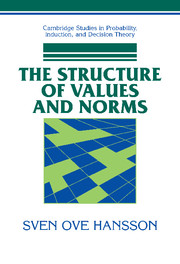Preface
Published online by Cambridge University Press: 13 August 2009
Summary
This book has grown out of my attempts to develop a unified formal representation of values and norms that reflects both their static and their dynamic properties. The subject is important for at least two reasons. First, formalized treatment may contribute to the clarification of certain issues in the basic philosophical theory of values and norms, such as the relation between the values of wholes and the values of their parts, the connections between values and norms, and the structure of normative codes.
Second, formal representations of values and norms are employed in several academic disciplines and specialties, notably economics, jurisprudence, decision theory, and social choice theory. Some of the foundational issues of these subjects are closely connected to philosophical issues that will be treated in this book.
The philosophical theory of values and norms has much to learn from the problems it encounters in applications. I hope it can in return provide safer – or at least better understood – foundations for these applications.
Chapter 1 offers some preliminary remarks on the usefulness and the limitations of formalization in this branch of philosophy. Chapter 2 introduces exclusionary preferences, that is, preferences that refer to mutually exclusive alternatives. In Chapter 3, a representation is introduced for preference states, and in Chapter 4 various operations of change on preference states are investigated.
The term combinative preferences will be used to refer to preferences with relata that are not necessarily mutually exclusive. The strategy adopted here is to derive combinative preferences from exclusionary preferences.
Information
- Type
- Chapter
- Information
- The Structure of Values and Norms , pp. xi - xivPublisher: Cambridge University PressPrint publication year: 2001
